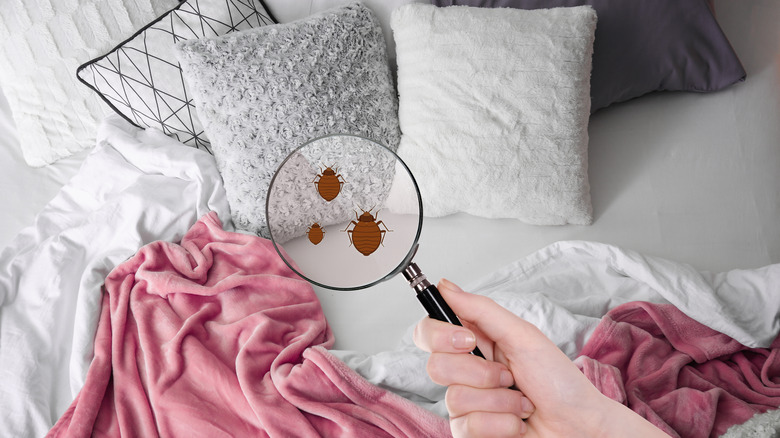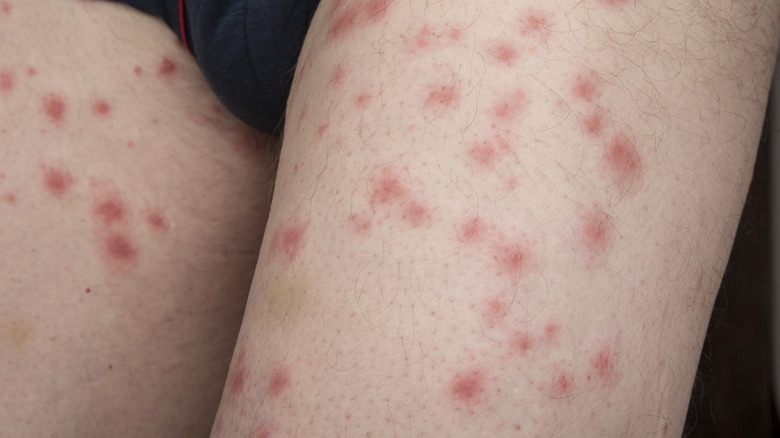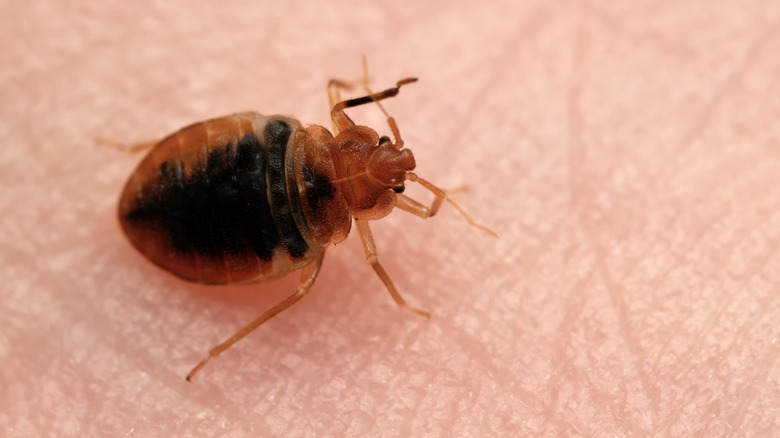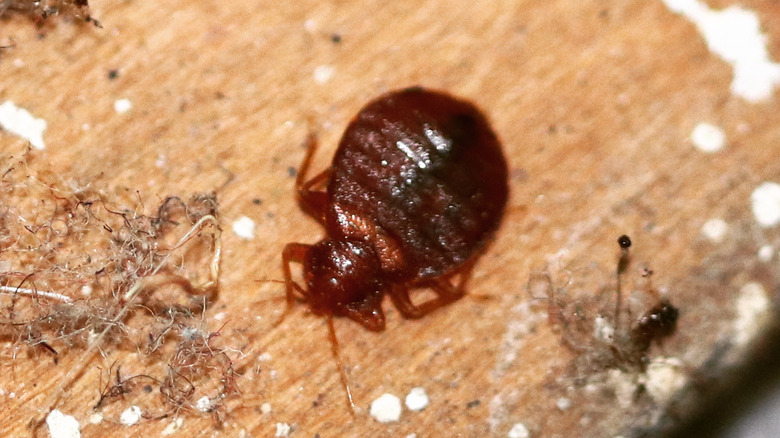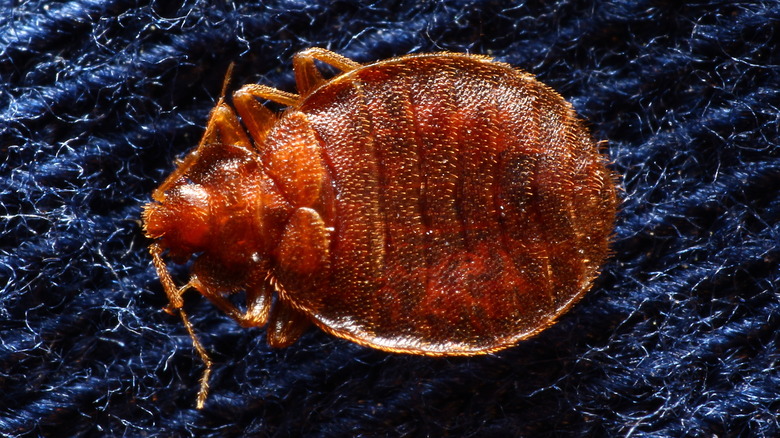Everything You Wanted To Know About Bed Bugs
Let's be clear, bed bugs: Nobody likes you. While you don't spread disease as far as we know, your lifestyle of biting humans while they sleep makes you our sworn enemy. But along with despising you, we have to kind of admire the persistence of you plucky little pests.
And bed bugs are indeed bugs — that's not a misnomer like "ringworm." In fact, that's why they're technically called "bed bugs" and not "bedbugs. While the one-word name is one you'll find in the dictionary, the two-word version is more scientific. Entomologists say bed bugs are "true bugs," that is, they're in the group of insects that's given the name "bug" by science. When an insect's common name is accurate in that way, it's spelled as two words, according to the Entomological Society of America. Think: honey bee, house fly, and yes, bed bug. Conversely, an inaccurate name is often spelled as one word. A dragonfly, for example, isn't actually in the fly family.
Whatever you call them, though, they've been cohabiting with us since we lived together in caves. They're mentioned in ancient Greek literature, the Talmud, and the New Testament, according to the UC Riverside Center for Invasive Species Research. In the early 20th century, it seemed like we could finally be rid of 'em. But danged if bed bugs didn't develop resistance to our modern pesticides, and bounce back stronger than ever. Well played, you creepy little bloodsuckers. Here's everything else you need to know about these bed-dwelling critters.
Bed bugs have been around since the dinosaurs
A little respect, maybe, for our tiny parasitic bedmates? They belong to an ancient lineage, one that's been walking — er, crawling — the earth for more than 100 million years. This has them sharing space with Cretaceous Period dinosaurs like Tyrannosaurus Rex, according to a 2019 examination of bed bug DNA.
Before cozying up to human beings, it's believed that bed bugs lived on bats (who's the bloodsucker now, Dracula?). It was assumed that these were the first hosts that bed bugs evolved to parasitize. But researchers who compared the DNA of several bed bug species concluded that the insects evolved some 30 million years before any bats were around. Whose blood they were drinking back in the day isn't yet known, but it probably wasn't dinosaur blood. Bed bugs prefer to feed on animals that sleep in a consistent spot, like a nest or roost — or, you know, your bed.
The DNA analysis also showed that, unlike other parasites, some bed bug species are able to switch to a new host if opportunity allows. In fact, bed bugs have switched from other hosts to feed on human beings at least three different times in our history (via University of Sheffield).
You'll notice a bite before you see a bed bug
Since bed bugs themselves can be hard to spot — they basically come out of hiding to feed on you in your sleep, then retreat to their lair after 4 to 12 minutes — often their bites are what people notice first, according to the American Academy of Dermatology. But it's not always easy to tell when exactly the bed bugs bite. You won't feel it when it happens because, for one thing, you're sleeping and secondly, the bugs release a substance that blocks the sensation (via American Camp Association). Even after the fact, some people don't notice the bite(s). Some people develop a reaction immediately; in other cases, it takes a few days for a red, itchy welt to appear. If you're bitten repeatedly, your body may become more sensitive, causing the reaction to happen more quickly.
Bed bug bites don't look all that different from other common insect bites. "Clues that can suggest the presence of bed bugs include finding red, itchy bites upon awakening — especially if the bites line up in a row on the skin," Dr. Jorge Parada, medical director of infection control for the Loyola University Health System, told Newswise. They can also appear in a zigzag pattern and tend to appear on areas of your skin that were exposed during sleep. The bites can take weeks to heal, but generally don't require any special treatment, Dr. Parada added. Over-the-counter or prescription creams can help with the itch.
Bed bugs leave telltale signs
Bed bugs stay hidden when they're not feeding. They avoid light and they're tiny, about the size of an apple seed at their biggest (an adult that's just fed), and as small as a poppy seed if they're young or haven't fed. So it's quite possible you'll never see them, according to the American Academy of Dermatology (AAD). Their bites may be a clue to their presence in your home, of course, but if you're on a trip, you'll want to know if they're there before you unpack — let alone get into bed.
What should you look for? First, odor. The chemicals that bed bugs produce to communicate have a sweet, musty smell. It might be evident with a large infestation, though not everyone can smell it. Second, check for blood specks. Check mattresses, sheets and other bedding, box springs, headboards, as well as upholstered furniture, for spots of blood left behind by feeding bed bugs.
Tiny black spots in any of the above locations could also indicate bed bugs, because the spots may be — wait for it — bed bug poop. While you're checking, you might also find the outer shells that the bugs shed (via AAD). Any of these signifiers are cause to ask for a different room when you're traveling. And at home, they could be reason to consult with a pest management professional.
Bed bugs laugh at your insecticides
It seemed like we had bed bugs on the run. In the middle of the last century, incidences of bed bug infestation dropped significantly, at least in developed countries. Modern science had given us pesticides that seemed capable of putting our ancient foes out of action for good. But then, as the 20th century turned, those creepy-crawly little creeps made a comeback. By 2010, 95% of pest management companies in the U.S. reported encountering a bed bug infestation in the previous year, compared to 25% in 2000 (via American Academy of Family Physicians).
A big reason for the resurgence: The bugs developed resistance to the pesticides we'd been using to kill them. In fact, one study published in Scientific Reports determined that bed bugs have at least 14 different genes that can protect them from pesticides. These genes do everything from breaking down toxic chemicals to preventing pesticides from attaching to their target. Another study found that some bed bugs have a cuticle (shell) that's 16% thicker, protecting them from pesticides that felled their thinner-skinned cohorts.
Bed bugs can handle freezing temps way longer than you can
One tactic in the war against bed bugs is to freeze them to death. The idea is to wrap infested clothing or other small items in plastic bags, and place them in a freezer for an icy demise.
The challenge is the cursed creatures are more resistant to cold temperatures than you might think. Like many insects, bed bugs have the ability to lower the freezing point of their body fluids as a defense against extreme cold. Researchers put this to the test by exposing bed bugs, including eggs and immature insects as well as adults, to freezing temperatures. They used specialized lab equipment, and also placed bed bugs in standard household freezers. The results showed that at about 3 degrees Fahrenheit (-16 Celcius), bed bugs can live for up to 80 hours. They can handle temperatures of 5 degrees F (-15 C) for 3.5 days, and a temperature of -4 F (-20 C) will kill them after 48 hours.
Since most home freezers are set to 0 F (-17.8 C), the study authors recommend keeping affected items on ice for at least 3.5 days to eliminate bed bugs. Place them in a sealed plastic bag to prevent condensation damage ... and to keep chilly bed bugs from escaping into the freezer.
You can trap your own bed bugs
Bed bugs are good at hiding. If you're wondering whether they're hiding in your bed, or your walls, or the chair you're sitting in right now, one way to find out is to take advantage of their weakness: They are not good at climbing smooth surfaces. That's the principle behind what's called a bed bug interceptor trap. Essentially, it's a container that bed bugs climb into when they make their nighttime creep from their hiding spots for a fresh meal (you). Once in the trap, the smooth walls prevent them from escaping. And you can make one yourself, with instructions from the University of Florida Institute of Food and Agricultural Sciences.
The idea is to place a small plastic container, like a food storage container, in the center of a large container, lids off. Then place the trap under the leg of a suspect couch, chair, or bed. (You'll want multiple traps to cover all four legs.) Bugs trying to climb onto the furniture, or climbing down off the furniture, will be able to get into the trap via strategically placed strips of masking tape. And then they'll find themselves trapped in the space between the inner and outer containers, unable to climb out. If you try it, be sure to move the furniture away from any walls, and don't let bedding touch the floor, so the critters don't have any other route to follow.
Some bed bugs can climb out of traps
There are two species of bed bugs that are responsible for skeeving out the human race. The common bed bug is widespread in temperate regions of the world, including the United States. The tropical bed bug, as its name suggests, is found in tropical regions (via FL Bed Bug Experts). However, it's also been found in some warm nontropical regions, including parts of Florida. One key difference between the two species was documented a few years ago: The tropical bed bug is a better climber.
An important tool for managing (getting rid of) bed bug populations is the "pitfall" trap, which bed bugs can't climb out of because the inner walls are too smooth. Strategically placed pitfall traps can reveal the presence of bed bugs and act as a barrier to keep them from colonizing uninfested furniture. You can even make one yourself.
Researchers tested the ability of both species to escape from various commercially available pitfall traps. They also measured how much force their teeny bug legs could exert. It turned out that the tropical bed bugs had no problem climbing out of all the traps tested. Laboratory measurements confirmed that the tropical bugs were generating more force; microscopic scans showed they have extra hairs on their legs that help them climb. This could mean that estimates of tropical bed bug populations which depend on pit traps are inaccurate, the researchers said. It also casts doubt on the effectiveness of such traps in tropical parts of the world.
Bed bugs like your laundry
Yup, bed bugs are gross. But their presence doesn't have anything to do with the cleanliness of the environment they're in. Bed bugs can be found in developing and developed nations, in 5-star hotels and resorts, in cruise ships and apartments — basically anywhere that humans bed down. They tend to live within 8 feet of a place where people sleep according to the Centers for Disease Control and Prevention.
They like us! More specifically, they like our smell. So much so that, according to one study, bed bugs are attracted to the scent of our used clothes. Researchers placed a bag of laundered or recently worn clothing into identical temperature-controlled rooms and released ten bed bugs into each room. Four days later, the bugs were twice as likely to be found on the soiled laundry than the clean clothes, explained the University of Sheffield.
According to the researchers, bed bugs can detect 104 different chemicals released in the human scent. Some of these are likely left behind in clothing after it's been worn, and so they attract the bugs. This may be one way that bed bugs spread across long distances. They find their way into soiled laundry in, say, a hotel room, and hitchhike in a suitcase or laundry bag to a new home.
Those ultrasonic bug repellers don't work
One of the ways bed bugs communicate with each other is by releasing chemical pheromones to signal alarm or to encourage or discourage mating. Understanding how these chemicals work could someday lead to more effective treatments to control bed bugs. Since other insects related to bed bugs also communicate by sound, a research team wondered if that might provide a method for keeping the bugs away.
Unfortunately, it doesn't seem like this approach is a sound strategy. The researchers tested commercially available ultrasonic pest repelling devices, the kind that promise to drive away vermin using frequencies of sound that humans can't hear (via Entomological Society of America). One of them was even marketed as a bed bug repeller. But laboratory tests showed that bed bugs were not deterred by (nor attracted to) the devices. This is par for the course as far as ultrasonic pest repellers go, the researchers said. There's little evidence that any of them work, and some studies have found that they actually attract insects or cause them to bite more.
One potentially interesting avenue of future research exists. It's possible that bed bugs use sound to find their hosts. So instead of ultrasonic sounds, perhaps simulated human-sounding noises, like snoring, could lure bed bugs to their doom.
Bed bugs have favorite colors
Believe it or not, some insects, bed bugs included, can see color. This might seem of limited use for bugs that come out at night, but they sometimes seek hiding places when it's light out. It turns out that color plays a role for bed bugs looking for a place to hide. As part of a study published in the Journal of Medical Entomology, researchers tested this by placing bed bugs in a petri dish that contained folded cards of various hues, then recording which of these "harborages" the bugs moved to over the course of 10 minutes.
The insects showed a preference for hiding under red and black cards, possibly because both colors are dark to their vision. And since bed bugs are red, that color might suggest other bed bugs are present (bed bugs live in groups). Sex affects this preference, though; female bed bugs preferred lilac or violet harborages. Yellow and green harborages were the least preferred colors; they actually seemed to repel the bugs. These colors might be avoided because they suggest a brightly lit area. A similar dislike for green and yellow has been found among mosquitoes and houseflies. But before you go out and buy new yellow sheets, keep in mind that these color preferences were related to bed bugs seeking shelter, not looking for their next meal.
Bed bug population can double in just over two weeks
Even though they're related to the kissing bug, there's not much romance in a bed bug's life. After adult bed bugs feed, mating tends to follow. The male bed bug transfers his sperm to the female not by inserting his reproductive organ into her genitalia, but by stabbing it through her body wall into a specialized organ. Females can mate several times in succession, but they'll lay more eggs if they can avoid multiple matings and heal the damage it causes. (Immature bugs, and males, release chemical signals to keep from being stabbed by randy male mating attempts.)
As long as she has blood to feed on, a fertilized female can lay up to 20 eggs after every meal, until she's used up all the sperm from mating. She can mate with her own offspring and produce 113 eggs in her yearlong lifespan. About 97% of her eggs will hatch successfully and 80% will survive to adulthood, which is at least 37 days. This all means that a bed bug population can double every 16 days, according to the Virginia Cooperative Extension.
Full disclosure: Kissing bugs aren't romantic either. They're called that because of their tendency to bite people on the mouth.
Laws help stop bed bugs from spreading
While there are an array of methods (of varying effectiveness) available for dealing with bed bug infestations, one especially useful tool to keep them in check is legislation. An analysis using U.S. Census data and other statistics examined the impact of laws requiring landlords to disclose bed bug infestations. The researchers not only found that these laws reduce infestation rates, but over time they also lead to cost savings for both landlords and tenants.
Disclosing an infestation initially costs landlords money because it results in vacancies and the expense of eliminating the bugs. But within five years, landlords come out ahead since treatment prevents the bed bugs from infecting other rental units. Plus, the bug-free properties experience less turnover of tenants. Renters also save money when these laws are in place since they don't have to replace infected furniture or move out.
According to the researchers, this type of legislation can be an important arrow in the anti-BB quiver. "Our work suggests that while it can be extremely difficult to eliminate bed bugs from homes, it might not be so difficult to eliminate them from cities," study author and epidemiologist Michael Z. Levy said in a press release.
The EPA can help you fight back against bed bugs
So you've got a bed bug problem? What should you do first (after screaming)? A good first step in figuring out your battle plan is to visit the U.S. Environmental Protection Agency's bed bug information hub.
According to the EPA, ridding your home of bed bugs takes time and patience. You're unlikely to find a quick fix because the little bastards are resistant to many of the techniques we deploy against them. You can try to eliminate them yourself or hire a professional. Either way, an integrated pest management (IPM) approach offers a mix of chemical and non-chemical methods in an attempt to minimize cost and environmental hazards. You'll have better success if you prepare for the treatment first, by cleaning, reducing clutter, and taking other steps to eliminate bed bug habitats, advised the EPA.
The EPA has registered more than 300 pesticides for use against bed bugs. If you're going that route, their product search tool can help you evaluate your options. The site also has a searchable "information clearinghouse" with info to help communities, property owners, pest management professionals, and hospitals as well as consumers. You'll also find links to local resources and information about bed bug laws and regulations.
Bed bugs might bug you even after they're gone
Dealing with a bed bug infestation may cause subsequent mental health effects, including insomnia, nightmares, and even flashbacks, according to a study published in The American Journal of Medicine. However, a comprehensive analysis of bed bug data found that more research is needed to establish the true scope of this problem.
It seems that the bugs can also leave behind physical traces after they've been eradicated. Their feces contain histamine, a chemical that can trigger an allergic reaction when ingested. For some background: Our immune systems also make histamine to cause sneezing, tearing, and other reactions to eject allergens from our bodies.
Researchers sampled house dust from 29 apartments, some of which were infested with bed bugs, in which case dust was collected before and after treatment. Homes that had no bed bug presence showed only traced amounts of histamine in the dust, but levels were high where bed bugs were present. And they stayed high even three months after bed bugs had been eliminated. Histamine can provoke allergic responses and asthma, the researchers said, so bed bugs might trigger allergies in a manner similar to cockroaches and dust mites, even after they're gone from the premises.
What do bed bugs look like?
We can talk about bed bug prevention and how bed bugs can be harmful to your home and your body. But if you don't know what to look for when actively searching out bed bugs, then you may not even know if you stumble across one.
Because they're so small, bed bugs aren't easy to spot on their own. Still, you can see adults with your naked eye. Adult bed bugs are reddish-brown in color with a slightly translucent body. They have a long oval body shape that becomes rounder after they eat. They have short, thick antennae that sprout from the upper sides of the head and are much shorter than a cockroach's. Young bed bugs are much more difficult to see, and it's unlikely that you'll notice them unless you look very closely. Their color varies from translucent to a soft white, so they often blend right in with bedding and mattresses. Bed bug eggs are the most difficult to spot, as they're super tiny and white.
Bed bugs are attracted to warmth and carbon dioxide
Bed bugs often get a negative connotation. Many people believe they tend to hide out in unclean or unsanitary homes. In reality, the EPA says that bed bugs aren't necessarily drawn to dirt and ick. Instead, clutter simply makes it easier for them to hide than in a mess-free zone. Bed bugs will still make their way into clean and tidy homes if they feel like it will become a safe haven for their colony.
In addition to blood, bed bugs are attracted to warm spaces. Of course, cluttered areas tend to make for a cozy, warm spot for their families. What else produces heat? Bodies, of course, especially when they're sleeping. This is one reason why bed bugs tend to congregate around beds and hide in mattresses. Another reason is that they like carbon dioxide, which humans produce when they breathe out air. The mixture of breathing and heat release as you sleep is much more welcoming for a bed bug family than a dirty home.
Bed bugs can wait a year until their next meal
It's no secret that bed bugs are difficult to get rid of. Once you learn that you have an infestation, it can take a few weeks — or even months — to curb the problem. Part of the reason why having bed bugs is such a challenging problem is that these critters are hardy. They don't need much to survive, so they can last a while even when they aren't in their ideal conditions.
A feature that helps them keep thriving is that they don't need to eat every day or even every week. In fact, according to the University of California's Integrated Pest Management Program, some adult bed bugs can live past a year without eating if other conditions meet their needs. Young nymphs can even last 20 days or more in between each feeding. So, as long as they have a warm place to hide out, bed bugs could take over your space and keep reproducing, making the cycle even tougher to stop.
Some people and places are more susceptible to bed bugs than others
Why do some homes and places get bed bugs, while others can spend a lifetime never experiencing a bed bug infestation? Some places are simply more susceptible to hosting bed bugs than other places. For instance, signs of bed bugs are notoriously spotted at hotels because of the number of travelers that pass through. While bed bugs don't typically cling to humans, they certainly can hide in clothing or luggage, joining a traveler on their trip and making their hotel room their new home.
Similarly, daycares and schools can also become home to bed bugs hiding in backpacks or clothing. And it's not entirely uncommon for bed bugs to transfer from one place to another by hitching a ride with social workers and emergency personnel, like police officers or firefighters, who might enter several homes or businesses each day. Medical facilities and office buildings could also find bed bugs more commonly than other places without as many people in and out each day, putting their workers at risk of bringing a few back to their homes.

